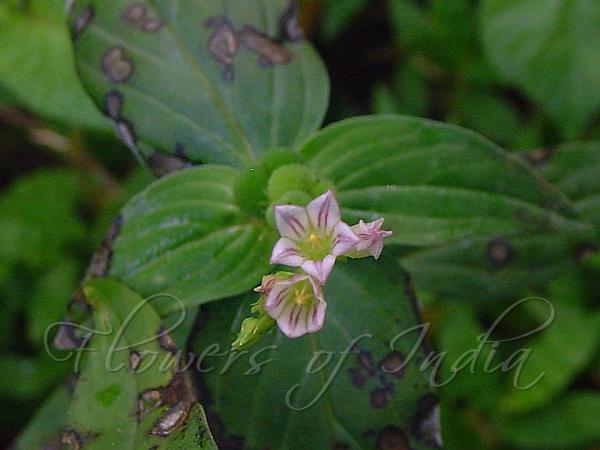|
| Wormbush |
|

|

| File size | 189925 |
| Original date | 8/30/14 12:55 PM |
| Resolution | 960 x 720 |
| Flash | Flash did not fire |
| Focal length | 6.3mm |
| Exposure time | 1/160s |
| Aperture | 3.8 |
| Focus Distance | |
| Metering Mode | Spot |
| Camera make | SONY |
| Camera model | DSC-P52 |
| Sensor type |
|
|
|
|
Photo: |
Botanical name: Spigelia anthelmia Family: Loganiaceae (Logania family)
Synonyms: Spigelia stipularis, Spigelia nervosa, Spigelia fruticulosa
Synonyms: Spigelia stipularis, Spigelia nervosa, Spigelia fruticulosa
Wormbush is an anual weed with stem erect, hollow,
hairless. Leaves are opposite, with an apical pseudo-whorl of 2
decussate pairs, simple and entire, stipules united, broad-triangular,
stalk up to 1 cm long. Leaves are ovate-oblong to ovate-lanceolate,
4-18 cm x 1-6 cm, base obtuse to cuneate, tip long-pointed.
Inflorescence is a terminal or axillary spike up to 15 cm long,
many-flowered; peduncle very short; bracts sepal-like. Flowers are
bisexual, regular, 5-merous, sessile; sepals free, slightly unequal,
2-6 mm long, pale green. Flowers are 8-17 mm long, tube 6-15 mm long,
lobes equal, triangular, 2-2.5 mm long, lilac to white, or tube white
and lobes pale pink, with or without 5 pairs of reddish lines inside.
Stamens are inserted just below the middle of the corolla tube,
included; ovary superior, globose, glabrous, 2-celled, style slightly
exserted. Fruit a capsule consisting of 2 ellipsoid parts, 4-5 mm x 5-6
mm, sharp-warty, green, lobes dehiscent with 4 valves, a boat-shaped
base remaining in the persistent calyx, with warty seeds. Wormbush or
pinkroot is very poisonous; it contains the alkaloid Spigeline that
acts upon the heart, especially the endocardium. In large doses it
debilitates the heart. Wormbush is a native of the West Indies and of
South America, but is widely naturalized.
Medicinal uses: Spigelia anthelmia combats
intestinal worms. Both roots and leaves are anthelminthic. In the
Americas Spigelia anthelmia is said to be one of the best vermifuges,
and is renowned as a medicine against spasmodic and nervous attacks.
Roots of Demerara pinkroot have acro narcotic qualities (capable of
producing both narcotic and irritant effects).
Spigelia anthelmia combats
intestinal worms. Both roots and leaves are anthelminthic. In the
Americas Spigelia anthelmia is said to be one of the best vermifuges,
and is renowned as a medicine against spasmodic and nervous attacks.
Roots of Demerara pinkroot have acro narcotic qualities (capable of
producing both narcotic and irritant effects).
Medicinal uses:
 Spigelia anthelmia combats
intestinal worms. Both roots and leaves are anthelminthic. In the
Americas Spigelia anthelmia is said to be one of the best vermifuges,
and is renowned as a medicine against spasmodic and nervous attacks.
Roots of Demerara pinkroot have acro narcotic qualities (capable of
producing both narcotic and irritant effects).
Spigelia anthelmia combats
intestinal worms. Both roots and leaves are anthelminthic. In the
Americas Spigelia anthelmia is said to be one of the best vermifuges,
and is renowned as a medicine against spasmodic and nervous attacks.
Roots of Demerara pinkroot have acro narcotic qualities (capable of
producing both narcotic and irritant effects). | Identification credit: Prashant Awale | Photographed in Nagpur, Maharashtra. |
• Is this flower misidentified? If yes,